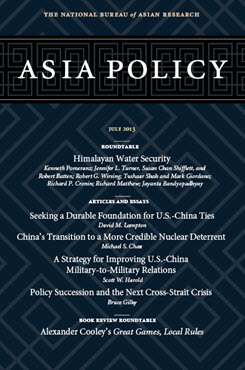Climate Change and Water Security in the Himalayan Region
This is one of seven essays in the roundtable “Himalayan Water Security: The Challenges for South and Southeast Asia.”
The hydrological system of the Himalayan region, upon which some 1.5 billion people depend, is under enormous stress. [1] Expected changes in water availability could threaten the region’s agricultural economies, place pressure on rapidly growing urban areas, impose constraints on economic development, amplify and introduce public health challenges, compel governments to use scarce funds to manage disasters, and contribute to corruption, institutional breakdown, and violent conflict on different scales. Policies are needed that bring the countries in this turbulent region together to address the factors causing water stress, ensure that new sources of water stress do not emerge or grow too large, and manage the mounting social effects of this problem.
Causes of Water Stress
Water stress typically refers to a decline in the annual supply of blue water measured on a per capita, or per hectare of arable land, basis and then compared with a global average or with local and projected demand. Water stress often manifests as scarcity, drought, and flooding. Population growth contributes to this problem, but it is the product of many other forces as well, most notably climate change. [2] According to the 2007 reports of the Intergovernmental Panel on Climate Change (IPCC), the mean temperature of the planet is increasing, ice sheets and mountain glaciers are melting, sea levels are rising, the planet’s mid-latitudes are becoming drier, the high and low latitudes are becoming wetter, and the frequency and intensity of floods, droughts, and wildfires are increasing. [3] By virtue of its geography, the Himalayan region is particularly vulnerable to the impact of climate change. The rise in mean temperature here has been higher than the global average, and this trend is expected to continue. Glacial retreat is occurring very quickly in the eastern and central Himalayas, and at high elevations this is expected to translate into a significant reduction of stream flow. At lower elevations, climate change is likely to affect the timing, location, and volume of the monsoon in significant ways. While there is much uncertainty, the evidence compiled to date describes a region at the forefront of global climate change.
Second, according to recent analysis of satellite data measuring fluctuations in gravitational force on the earth’s surface, both the South Asian subcontinent and the Tibetan Plateau, which the Himalayan, Hindu Kush, and Karakoram mountain ranges divide, are losing groundwater. While climate change might affect the replenishment of some stocks of groundwater, or lead to their contamination due to salt intrusion from rising sea levels, groundwater loss is due mainly to overuse for irrigation. This is a classic “tragedy of the commons” scenario, in which the small-scale unsustainable actions of individuals aggregate into enormous collective losses. Pakistan, for example, which is a very arid country, depends on groundwater for more than 50% of its irrigation and is especially sensitive to this trend.
Third, and further complicating matters, in recent years countries on both sides of the Himalayas have developed plans for hundreds of new dams, mainly for hydroelectric power but also as reservoirs to hedge against drought. All of Asia’s major rivers—including the Brahmaputra, Ganges, Indus, Irrawaddy, Mekong, Salween, Yangzte, and Yellow—originate in these mountains, and most of them begin across the Chinese border in Tibet. They represent enormous hydroelectric power potential, but large dams invariably impose large social and environmental costs—harnessing sacred waters, displacing people, affecting river and silt flows, and destroying habitats. Some analysts are concerned that the impacts of climate change on water have not been factored sufficiently into dam design. For example, dams may be damaged by outburst floods from glacial lakes or suffer higher than normal rates of evaporation from reservoirs due to warmer…
[1] I use the term “Himalayan region” to represent the area encompassing the large, young mountain ranges of Asia—the Karakoram, Himalayan, and Hindu Kush—that run from Afghanistan through Pakistan and India to China along with the Tibetan Plateau and the Indian subcontinent, which are separated by these mountain ranges and which depend on water flowing from them.
[2] Kenneth Pomeranz, “The Great Himalayan Watershed: Water Shortages, Mega-Projects and Environmental Politics in China, India, and Southeast Asia,” Asia-Pacific Journal, no. 29 (2009).
[3] S. Solomon, D. Qin, M. Manning, Z. Chen, M. Marquis, K.B. Averyt, M. Tignor, and H.L. Miller, eds., Contribution of Working Group I to the Fourth Assessment Report of the Intergovernmental Panel on Climate Change (Cambridge: Cambridge University Press, 2007), http://www.ipcc.ch/publications_and_data/ar4/wg1/en/contents.html.
[4] Simi Kamal, “Use of Water for Agriculture in Pakistan: Experiences and Challenges” (presentation at the Conference on the Future of Water for Food, University of Nebraska, Lincoln, May 3-5, 2009), http://research.unl.edu/events/futureofwater/ppt/SKNebraska.pdf.
[5] M. Tajuddin Sikder and K. Maudood Elahi, “Environmental Degradation and Global Warming—Consequences of Himalayan Mega Dams: A Review, American Journal of Environmental Protection 2, no. 1 (2013): 1-9.
About Asia Policy
Asia Policy is a peer-reviewed scholarly journal presenting policy-relevant academic research on the Asia-Pacific that draws clear and concise conclusions useful to today’s policymakers. Asia Policy is published quarterly in January, April, July, and October and accepts submissions on a rolling basis. Learn more


